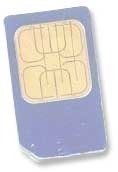SIM Card
A SIM (Subscriber Identity Module) card is a type of interface card that is found in most modern cell phones and contains the user’s account information as well as some types of media, such as contacts, pictures, and sometimes ringtones. A SIM card contains an ICCID, or Integrated Circuit Card ID, number that identifies the SIM card to the network, an IMSI, or International Mobile Subscriber Identity, number that identifies the person who is associated with the SIM card, cryptographic information for security purposes, temporary information concerning the local network the SIM card is connected to, a list of services the user is allowed to access, and a PIN and PUK for user authentication.
How SIM Cards Work
While SIM cards used to be the size of a standard credit card (85.60 mm × 53.98 mm × 0.76 mm), smaller phones have required the development of smaller SIM cards, which are now 25 mm × 15 mm × 0.76 mm in size. The SIM card can be found in the back of any standard cell phone behind the battery. The SIM card is contained within a small tray and can be removed, replaced, or moved to a new phone at any time. However, while the SIM card may contain the most essential information a user will need to keep, such as his/her contacts, cell phone number, and services, the user will need to transfer media files, such as pictures, videos, and messages through other means.
Applications
While many prepaid phones contain user information in the phone itself or have a sealed SIM card that cannot be seen or removed, contract cell phone plans require a SIM card in case the user ever needs to transfer his/her account to a new phone. Because SIM cards are removable, users can retain all of their services, contacts, and their own cell phone number by simply pulling the SIM card out of one phone and inserting it into another.
Advantages
SIM cards have several important advantages. For example, a SIM card can be taken from one phone and placed in another. This allows the user to transfer their services and personal information to a new phone without having to manually rewrite every file or purchase a new service plan. SIM cards are also advantageous because they are conveniently stored behind the battery of most phones, preventing damage and keeping the user’s data plan safe.
Disadvantages
While SIM cards are advantageous, they do lack several features that some users may desire. For example, SIM cards are not designed for personal storage and are, therefore, not capable of storing enough data to contain video files, large audio files, or large amounts of text messages. Additionally, SIM cards are made for a specific service plan that the user has with his/her service provider, preventing the user from using a SIM card in a cell phone made by a different company.


Comments - 5 Responses to “SIM Card”
Sorry but comments are closed at this time.